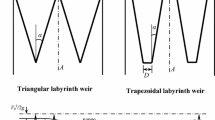Abstract
Labyrinth side weirs have significant advantages according to conventional side weirs in terms of discharge capacity. Labyrinth side weirs are especially advantageous in places where more discharge is required from small weir openings lengths. The most significant feature of labyrinth side weirs is their effective crest length, which enables them to discharge more flow. In this study, the situation where the discharge capacity is decreased due to the narrowing of the crest length of the labyrinth side weir for any reason was experimentally investigated in detail. It was also considered that the potential narrowing could be in the upstream weir crest length. The overflow from the remaining length of the crest was enabled by the 1/3, 2/3, and 3/3 closure of the upstream crest length of the labyrinth side weir. Therefore, it was attempted to determine the decrease in discharge capacity due to the narrowing in the effective crest length. The values of the discharge coefficient were obtained by using the De Marchi approach. The study was conducted for subcritical flow regimes and steady-state flow conditions. A total of 980 experimental runs were conducted in this study. As the length of upstream effective crest length of the triangular labyrinth side weir at the straight channel decreases, the discharge coefficient also decreases. By narrowing the length of effective upstream crest length in 1/3, 2/3, and 3/3 ratios, the total discharge capacity decreased by approximately 10%, 23%, and 48%, respectively.











Similar content being viewed by others
Abbreviations
- b :
-
Width of a channel
- C d :
-
Side-weir discharge coefficient
- F1 :
-
Froude number at an upstream end of side weir
- g :
-
Acceleration due to gravity
- h :
-
Main channel depth
- h1:
-
Flow depth at an upstream end of side weir at channel center
- h2:
-
Flow depth at a downstream end of side weir at channel center
- L :
-
Length (width) of side weir
- ℓ’:
-
Triangular labyrinth side weir semi-crest length
- p :
-
Height of weir crest
- Q :
-
Discharge in the main channel
- R :
-
Regression coefficient
- S :
-
Decrease in discharge capacity (%)
References
Ansari, U.; Patil, L.: Numerical analysis of triangular labyrinth side weir in triangular channel. ISH J. Hydraul. Eng. 28(sup1), 141–148 (2022)
Ikinciogulları, E.; Emiroglu, M.: Estimation of triangular labyrinth side weir discharge capacity using schmidt approach. Sigma J. Eng. Nat. Sci. 37(1), 289–303 (2019)
Kilic, Z.; Emin Emiroglu, M.: Study of hydraulic characteristics of trapezoidal piano key side weir using different approaches. Water Supply 22(8), 6672–6691 (2022)
Ben Said, M.; Ouamane, A.: Performance of rectangular labyrinth weir–an experimental and numerical study. Water Supply 22(4), 3628–3644 (2022)
Emiroglu, M.E.; Gogus, M.; Tunc, M.; Islamoglu, K.: Effects of antivortex structures installed on trapezoidal labyrinth side weirs on discharge capacity and scouring. J. Irrig. Drain. Eng. 143(6), 04017006 (2017)
Cosar, A.; Agaccioglu, H.: Discharge coefficient of a triangular side-weir located on a curved channel. J. Irrig. Drain. Eng. 130(5), 410–423 (2004)
Aydin, M.; Emiroglu, M.: Determination of capacity of labyrinth side weir by CFD. Flow Meas. Instrum. 29, 1–8 (2013)
Emiroglu, M.E.; Kaya, N.; Agaccioglu, H.: Discharge capacity of labyrinth side weir located on a straight channel. J. Irrig. Drain. Eng. 136(1), 37–46 (2010)
Emiroglu, M.E.; Aydin, M.C.; Kaya, N.: Discharge characteristics of a trapezoidal labyrinth side weir with one and two cycles in subcritical flow. J. Irrig. Drain. Eng. (2014). https://doi.org/10.1061/(ASCE)IR.1943-4774.0000709
De Marchi, G.: Essay on the performance of lateral weirs. L’Energia Electtrica Milano. 11(11), 849–860 (1934)
Emiroglu, M.E.; Agaccioglu, H.; Kaya, N.: Discharging capacity of rectangular side weirs in straight open channels. Flow Meas. Instrum. 22(4), 319–330 (2011)
Novák, P.; Cabelka, J.: Models in Hydraulic Engineering; Physical Principles and Design Applications. Pitman Advanced Publishing Program (1981)
Khode, B.V.; Tembhurkar, A.R.; Porey, P.D.; Ingle, R.N.: Experimental studies on flow over Labyrinth Weir. J. Irrig. Drain. Eng. 10, 1061 (2012)
Author information
Authors and Affiliations
Corresponding author
Rights and permissions
Springer Nature or its licensor (e.g. a society or other partner) holds exclusive rights to this article under a publishing agreement with the author(s) or other rightsholder(s); author self-archiving of the accepted manuscript version of this article is solely governed by the terms of such publishing agreement and applicable law.
About this article
Cite this article
Dogan, Y., Kaya, N. The Effects of Changing the Effective Crest Length of Labyrinth Side Weir on Discharge Capacity. Arab J Sci Eng 48, 5289–5304 (2023). https://doi.org/10.1007/s13369-022-07388-y
Received:
Accepted:
Published:
Issue Date:
DOI: https://doi.org/10.1007/s13369-022-07388-y




